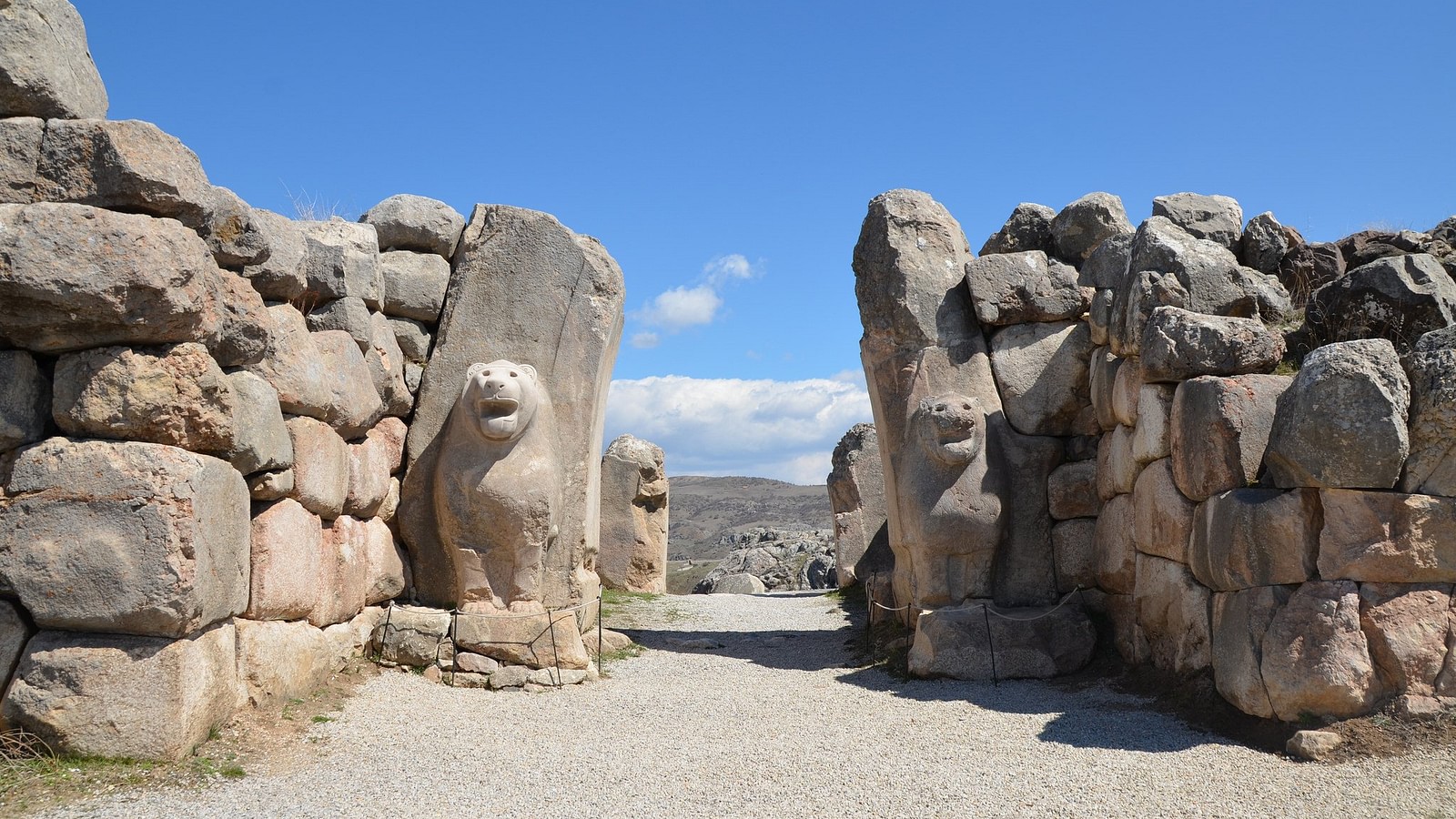Edmund Devine
“The foreign countries conspired in their islands. All at once the lands were removed and scattered in the fray. No land could resist their arms, from Hatti, Kode, Carchemish, Arzawa, and Alashiya on – being cut off at one time. A camp was set up in Amurru. They desolated its people, and its land was like that which had never existed. They were coming forward towards Egypt, while the flame was prepared for them. Their confederation was the Peleset, Tjeker, Shekelesh, Denen, and Weshesh lands united. They laid their hands upon the lands as far as the circuit of the earth. Their hearts were confident and trusting as they said “Our plans will succeed!”
-Description of the Sea Peoples by Pharoah Ramesses III, circa 1180 BC
(Note for use of the Editor: Hatti = Hittite, Carchemish = A viceroyalty of the Hittite empire at the time, Arzawa = An independent Kingdom antagonistic to the Hittites and allied with the Mycenean Greeks, Alashiya = A state that is situated somewhere in the Eastern Med. A trade power that was especially well known for its copper deposits. Possibly Cyprus by another name or the lands that are now around Thessaloniki. Peleset = cognate with Hebrew Peleshet, also known as the Philistines. Tjeker = Possibly the people inhabiting part of Syria at the time. Shekelesh = Pirates employed as part of the Lybian kingdom, possibly the Siculi people of Sicily. Weshesh = A people theorized as the Oscians, a south Italic people group.)
The beginning of one of the major international upsets of the proto-ancient world was the Bronze Age Collapse. There are many, many theories, hypotheses, and speculation upon the matter of this calamitous event. Dr. Enzmann had his own view of the events and from his notes I am to try and piece together a coherent tale of his opinion upon this apocalyptic event for the peoples of the Mediterranean. This shall be a series of six or seven posts as I continue to do research into this subject. This opening post shall be something to set the stage and name the big players in this conflict. In the closing posts, I shall compare Dr. Enzmann’s work to the consensus reality that modern Archaeologists and Historians have painted and see the difference betwixt the pair.
The time of the Bronze Age Collapse, (referred here-after as the BAC), was a time ridden with conflict for the Egyptian peoples. Just three-hundred and fifty years in the past the mighty and bloody-minded Hyksos regime was cast out and the last of their Pharaohs removed from the throne of Egypt by Pharoah Ahmose the 1st. It may surprise many that such a conflict that was wages centuries before the BAC would contribute so heavily to its occurrence but the main backers of the Hyksos dynasty of kings were the Hebrews. In the Bible Joshua helps found the Hyksos and until Ahmose I removed them from power they had overwhelming control over the Nile River Delta down to the border of the rival true Egyptian Pharaohs of the 16th and 17th Dynasties which ruled from Thebes. After the destruction of the Hyksos regime, Ahmose I founded the unified 18th Dynasty of Egypt. Beginning with the reign of Thutmose III, (also possibly the Biblical David), took over most of the Levant, doing battle with the Syrian kingdoms and Nubians to establish the largest Empire Egypt had ever seen. During this time he subjugated and enforced tribute of the Hebrew, Canaanite, and other tribes of the Levant further enflaming resentment within the peoples of that land to the Egyptian leaders. It was from the backs of the powerful rulers of the 18th Dynasty that the 19th Dynasty entered into it’s existence. This Dynasty was marked by conflicts with the Hittite Empire to their north and infighting within the Empire that caused the downfall of this Dynasty and the birth of the 20th Dynasty. These rulers, the last of the great rulers of Egypt were the ones faced with the wrath of the combined forces of those whom their forebears had angered and humiliated time and time again and who were the true targets of the coalition of nations and tribes now referred to as the ‘sea peoples’…
During this time the Hittite Empire, once feared and known across all the ancient world as a proud and powerful warrior people, was in decline. Their ‘New Kingdom’ period was marked by poor leadership, a declining sphere of influence of tributaries, both internal and external conflicts, and finally brought low by the combined coalition of ‘Sea peoples’ and climatological events. During the reign of Ramesses II and Hattusili III, a conflict was waged that brought both nations to a draw. Both fearful of growing Assyrian influence in Mesopotamia, a treaty was signed that fixed their boundaries through the lands of the Canaanites and set in motion an alliance betwixt the two states. By the time of Hattusili’s son, Tudhaliya IV, the Assyrians were hounding the Hittite’s door, pushing up the Euphrates into the Anatolian peninsula, taking tributaries of the Hittites and weakening the hold of Hittite domination of that region. Though during this time Tudhaliya IV managed to temporarily annex Cyprus, he lost most of his eastern lands to the Assyrians. In this weakened state the Hittite Empire had to face the seemingly sudden coalition of foreign powers directed against them as well as the Egyptians…
The next nation to cover is the Assyrians. During the time of the BAC, the Assyrian Empire was expanding, growing to surpass the diminishing and dying empire of Babylonia, and exerting influence all the way into Anatolia. Under the leadership of Ashur-resh-ishi I, Assyria was at the height of its power in Mesopotamia, and sought to profit off of the backs of the conflicts the western Mediterranean powers both amongst themselves and against the coalition of ‘Sea peoples’ that invaded their lands. He was also the man who cast down the reign of Nebuchadnezzar I and the effective removal of Babylonian influence in northern Mesopotamia and into the Levant. Though they profited off of the destabilizing effects of the BAC, the wider climatological changes and internal pressures caused the Assyrian Empire to shortly there-after beginning its decline and lead to another waxing of Babylonian power over Mesopotamia.
The Mycenaean state of Greece during this time was expanding its influence over the Aegean sea. After the collapse of the Minoan culture upon Crete Knossos, the capital of the Minoan peoples, became another center of Mycenaean power. Their interest in the Greek client vassal states of the Hittites brought them into conflict with that Empire and the other smaller kingdoms and tribes that adorned the coast of Anatolia. During this time the city of Wilusa, the Hittites name for Troy, was attacked by the Mycenean king Atreus. This caused the Hittite king to attempt to negotiate with the Myceneans, seeking to have them restore a balanced and peaceful state to the Aegean city-states and kingdoms. Though soon thereafter the first cracks of the decline of the Mycenaean peoples appeared with the return of the Heracleidae, the sons of Hercules. These peoples returned after being exiled after the death of Heracles and sought to reclaim the dominion he held over the Peloponnesus. They were led by the brothers Kresphontes and Temenos, and the twins Eurysthenes and Prokles. During this time they divided most of the Peloponnesus into three parts; Messenia by Kresphontes, Temenos took the North-east, and the twins Laconia, thusly becoming the first dual kings of Sparta. During this time there was internal upheaval and conflict betwixt the present order and power of the Mycenaeans and the returning Heracleidae. During this political and cultural conflict, the BAC occurred, plunging Greece into what is termed as the ‘Greek Dark Ages’ by historians today.
These nations were the major players in the region during and up to the BAC. Only one truly survived the BAC and continued in its similar nature, all the others were either wholly destroyed or their empires collapsed shortly after this conflict. From this conflict arose the powers of Phoenicia, the Philistines, the Israelites, Libya, and the Etruscans who all took part in this grand coalition to upset and blockade the Mediterranean, seeking to control it and establish themselves as the new order of power within the lands therein. For two hundred years these nations were successful in keeping the sea routes of the Mediterranean firmly under their command. These were as follows; Eilician Gate – Anatolia, Iron Gate – Danube, Carcassonne Gap – Garonne, Rhone-Brenner Pass, the gates of Hercules – Iberia, and the Pharaohs Canal – Nile Delta. They controlled either all of these locations or implemented a naval blockade of these lands to prevent wider trade and assistance from other nations and kingdoms around the Mediterranean, especially those of the Celts who soon discovered the power of bog iron, thus truly leading to the ‘Iron age’ as we know it today.
In conclusion, this post only shows the major players, and not the many, many minor kingdoms also caught up in this conflict, the next post shall explain the major players of the coalition of ‘Sea peoples’ and the climatological situation of the Mediterranean and why it matters so much to the wider conflict of the BAC. I hope you enjoyed this post and I look forward to continuing to show and explain the histories of the Enzmann universe as seen through the eyes of Dr. Robert Duncan Enzmann.





